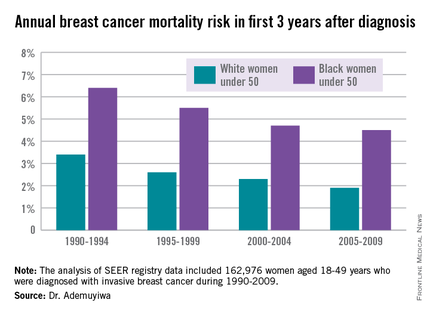SAN ANTONIO – Breast cancer mortality in American women under age 50 declined markedly among whites during a recent two-decade period, less so in blacks.
“The racial gaps in survival have not closed. Young black women continue to have a worse outcome than young whites,” Dr. Foluso O. Ademuyiwa said at the San Antonio Breast Cancer Symposium.
She presented an analysis of Surveillance, Epidemiology, and End Results (SEER) registry data that included 162,976 women diagnosed with invasive breast cancer at age 18-49 during 1990-2009. Whites accounted for 77.7% of the total, blacks 12.5%, and other races 9.8%.
Twenty percent of patients had died by the median followup of 85 months. Five- and 10-year overall survival rates were 87.9% and 79.5%, respectively, among white patients, 74.9% and 64.3% for blacks, and 88.5% and 80.7% for women of other races, reported Dr. Ademuyiwa of Washington University, St. Louis.
During all 5-year sections of the study period, the highest risk of breast cancer mortality was in the first 3 years following diagnosis. However, annual risk of mortality in the first 3 years declined for white women from 3.4% during 1990-1994 to 1.9% during 2005-2009, and from 6.4% during 1990-1994 to 4.5% during 2005-2009 for black women.
Young black breast cancer patients had a more aggressive tumor biology. Thirty-seven percent of them had estrogen receptor–negative tumors, compared with 24% of white patients. Their disease was also at a higher stage and grade at diagnosis. Moreover, their tumors were larger in size; only 34.5% of black patients’ tumors were less than 2 cm in size, compared with 47.3% for white patients and 45.3% for women of other races.
A greater proportion of the invasive breast cancer cases in young women were diagnosed in more recent years. Roughly 13% of all cases in the SEER registry for 1990-2009 were diagnosed in 1990-1994, 16% in 1995-1999, 35% in 2000-2004, and 36% during 2005-2009. The explanation for this trend may be more widespread use of screening, changes in the reproductive risk profile over time, or some combination of the two factors, according to Dr. Ademuyiwa.
She reported having no financial conflicts with regard to this study.


